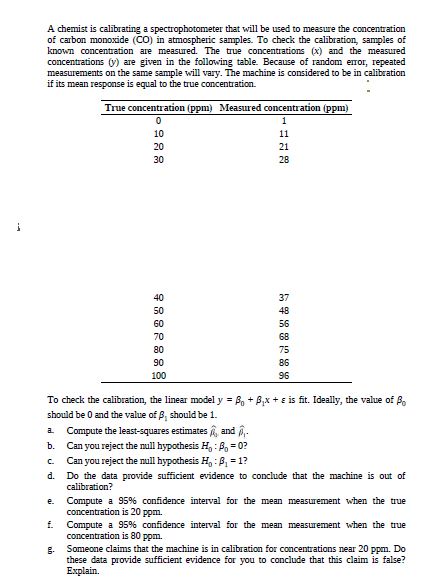A chemist is calibrating a spectrophotometer that will be used to measure the concentration of carbon monoxide (CO) in atmospheric samples. To check the calibration, samples of known concentration are measured. The true concentrations (x) and the measured concentrations (y) are given in the following table. Because of random eror, repeated measurements on the same sample will vary. The machine is considered to be in calibration if its mean response is equal to the true concentration. True concentration (ppm) Measured concentration (ppm) 10 11 20 21 30 28 40 37 50 48 60 56 70 68 80 75 90 86 100 96 To check the calibration, the linear model y = Bo + B,x + e is fit. Ideally, the value of B. should be 0 and the value of B, should be 1. Compute the least-squares estimates A and 6- a. b. Can you reject the null hypothesis H,: Bo = 0? Can you reject the null hypothesis H, : B, = 1? C. d. Do the data provide sufficient evidence to conclude that the machine is out of calibration? Compute a 95% confidence interval for the mean measurement when the true concentration is 20 ppm. e. f. Compute a 95% confidence interval for the mean measurement when the true concentration is 80 ppm. Someone claims that the machine is in calibration for concentrations near 20 ppm. Do these data provide sufficient evidence for you to conclude that this claim is false? Explain.
A chemist is calibrating a spectrophotometer that will be used to measure the concentration of carbon monoxide (CO) in atmospheric samples. To check the calibration, samples of known concentration are measured. The true concentrations (x) and the measured concentrations (y) are given in the following table. Because of random eror, repeated measurements on the same sample will vary. The machine is considered to be in calibration if its mean response is equal to the true concentration. True concentration (ppm) Measured concentration (ppm) 10 11 20 21 30 28 40 37 50 48 60 56 70 68 80 75 90 86 100 96 To check the calibration, the linear model y = Bo + B,x + e is fit. Ideally, the value of B. should be 0 and the value of B, should be 1. Compute the least-squares estimates A and 6- a. b. Can you reject the null hypothesis H,: Bo = 0? Can you reject the null hypothesis H, : B, = 1? C. d. Do the data provide sufficient evidence to conclude that the machine is out of calibration? Compute a 95% confidence interval for the mean measurement when the true concentration is 20 ppm. e. f. Compute a 95% confidence interval for the mean measurement when the true concentration is 80 ppm. Someone claims that the machine is in calibration for concentrations near 20 ppm. Do these data provide sufficient evidence for you to conclude that this claim is false? Explain.
Algebra & Trigonometry with Analytic Geometry
13th Edition
ISBN:9781133382119
Author:Swokowski
Publisher:Swokowski
Chapter6: The Trigonometric Functions
Section6.4: Values Of The Trigonometric Functions
Problem 23E
Related questions
Question

Transcribed Image Text:A chemist is calibrating a spectrophotometer that will be used to measure the concentration
of carbon monoxide (CO) in atmospheric samples. To check the calibration, samples of
known concentration are measured. The true concentrations (x) and the measured
concentrations (y) are given in the following table. Because of random eror, repeated
measurements on the same sample will vary. The machine is considered to be in calibration
if its mean response is equal to the true concentration.
True concentration (ppm) Measured concentration (ppm)
10
11
20
21
30
28
40
37
50
48
60
56
70
68
80
75
90
86
100
96
To check the calibration, the linear model y = Bo + B,x + e is fit. Ideally, the value of B.
should be 0 and the value of B, should be 1.
Compute the least-squares estimates A and 6-
a.
b.
Can you reject the null hypothesis H,: Bo = 0?
Can you reject the null hypothesis H, : B, = 1?
C.
d.
Do the data provide sufficient evidence to conclude that the machine is out of
calibration?
Compute a 95% confidence interval for the mean measurement when the true
concentration is 20 ppm.
e.
f.
Compute a 95% confidence interval for the mean measurement when the true
concentration is 80 ppm.
Someone claims that the machine is in calibration for concentrations near 20 ppm. Do
these data provide sufficient evidence for you to conclude that this claim is false?
Explain.
Expert Solution
This question has been solved!
Explore an expertly crafted, step-by-step solution for a thorough understanding of key concepts.
This is a popular solution!
Trending now
This is a popular solution!
Step by step
Solved in 4 steps with 3 images

Recommended textbooks for you

Algebra & Trigonometry with Analytic Geometry
Algebra
ISBN:
9781133382119
Author:
Swokowski
Publisher:
Cengage

Algebra & Trigonometry with Analytic Geometry
Algebra
ISBN:
9781133382119
Author:
Swokowski
Publisher:
Cengage